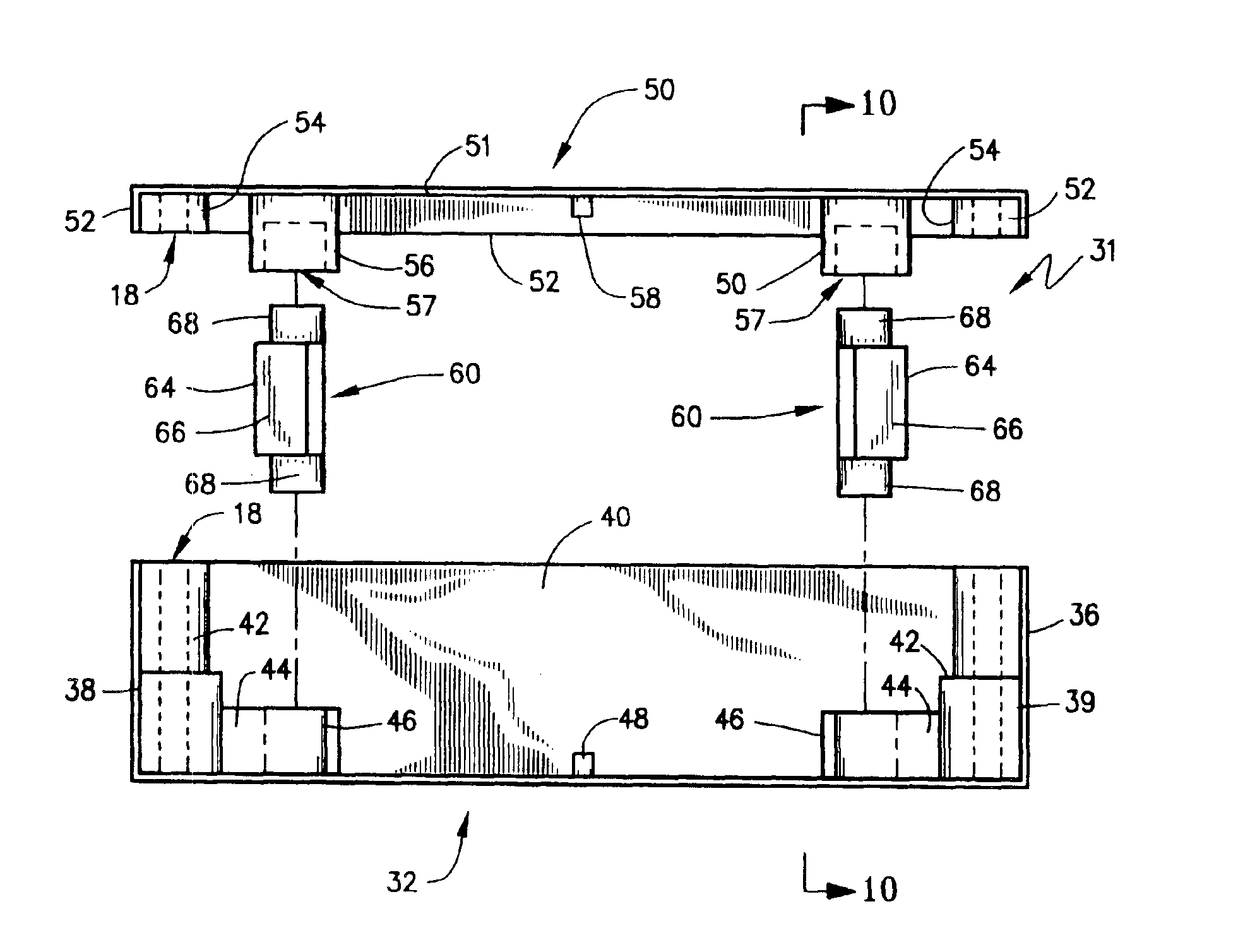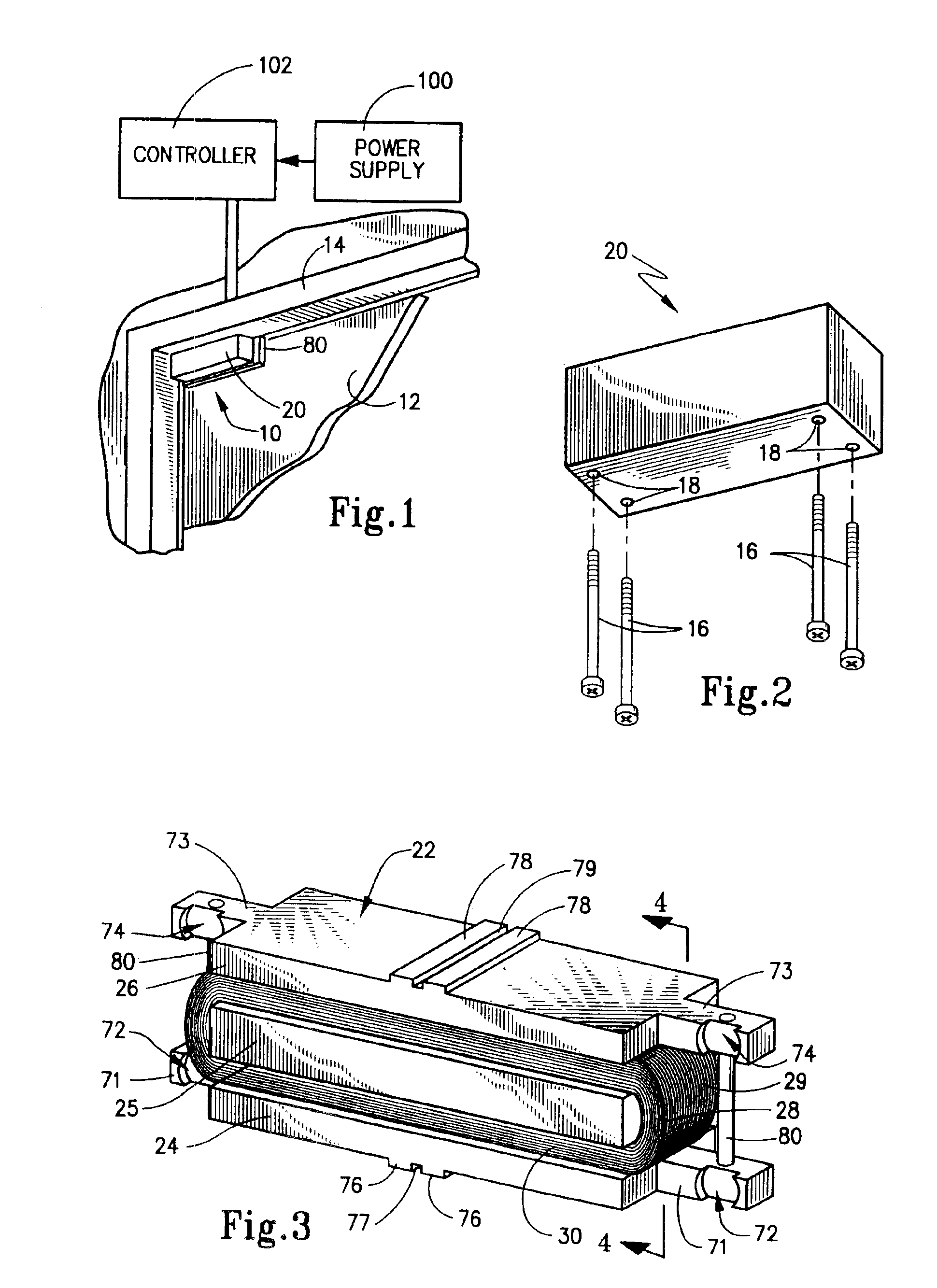Electromechanical locking method and device
a technology of electromechanical and locking method, applied in the field of electromechanical locking method and device, electromechanical devices, etc., can solve the problems of increasing the size of the electromagnet, increasing the cost of the magnet as well as power consumption, and not being able to easily open the door by people,
- Summary
- Abstract
- Description
- Claims
- Application Information
AI Technical Summary
Benefits of technology
Problems solved by technology
Method used
Image
Examples
first embodiment
[0050]A representative latch element for this first embodiment of the present invention is depicted in FIGS. 7 and 8. Here, latch element 60 is in the form of a pawl having a base 62 and an elongated arm 64 that terminates in a hook 66. A pair of oppositely projecting trunnions 68 are cylindrical in configuration and extend oppositely outwardly from base 62. Arm 64 is provided with a post 65 on one side thereof and an inclined plane 69 forms a cam surface, the purpose of which is described in greater detail below.
[0051]With reference now to FIG. 9, the assembly of base 32 and cover 50 to form housing 31 along with the mounting of a pair of latch elements 60 is shown. As may be seen in FIG. 9, when cover 50 is placed on base 32, blocks 54 will abut blocks 42 with bores 18 being aligned. It may be here noted that blocks 42 may be tiered, for dimensional reasons, if desired. Each of seats 46 are opposed to a respective seat 56 to form a seat pair for mounting trunnions 68 of each latch...
third embodiment
[0062]the present invention is shown in FIG. 21. Here, it may be seen that the electromagnet 225 is formed as part of the catch piece 290. Head portion 294 provides a pair of lips 296, and it could be understood that catch piece 290 can be formed of a core material for the electromagnetic coils that form electromagnet 225. In any event, latching assembly 220 includes an arming member 223 that is slideably mounted on posts 228 and biased by springs 282 as shown in FIG. 21. Latching elements 260 are pivotally mounted at opposite ends of plate 224 on axles 261 and, when contacted by catch piece 290 are held in the release position (shown in FIG. 21) by means of suitable cam surfaces. Coil springs (not shown but similar to those described below in FIGS. 22 and 23) extend around axles 262 to bias latching members 260 into the capture position. However, due to the action of springs 282, arming member 223 forces cam members 260 into the release position, as described above. When current is...
fourth embodiment
[0063]Finally, turning to FIGS. 22 and 23, the present invention is shown. Here, latch assembly 320 is in the form of a plate 24 that is mounted to a first structure 314 by means of a bolt 322 that has a base block 340 received in a cavity 342 formed therein. A spring 382 biases plate 320 into the first position adjacent structure 314. Catch 390 is mounted to a second structure 312 and comes into abutment with plate 324 when in a received position in latch assembly 320. Plate 324 has associated therewith an electromagnet 325, and a pair of latch elements 360 are rotatably journaled on axles 361 and are biased into the capture state by means of coil springs 384.
[0064]As is shown in FIG. 23, when current is supplied to electromagnet 325, catch piece 390 is magnetically attracted to plate 324. Movement of catch piece 390 away from structural piece 314 moves plate 324 away from piece 314 against the force of compression spring 382. When this occurs, springs 384 act to rotate latch eleme...
PUM
 Login to View More
Login to View More Abstract
Description
Claims
Application Information
 Login to View More
Login to View More - R&D
- Intellectual Property
- Life Sciences
- Materials
- Tech Scout
- Unparalleled Data Quality
- Higher Quality Content
- 60% Fewer Hallucinations
Browse by: Latest US Patents, China's latest patents, Technical Efficacy Thesaurus, Application Domain, Technology Topic, Popular Technical Reports.
© 2025 PatSnap. All rights reserved.Legal|Privacy policy|Modern Slavery Act Transparency Statement|Sitemap|About US| Contact US: help@patsnap.com



